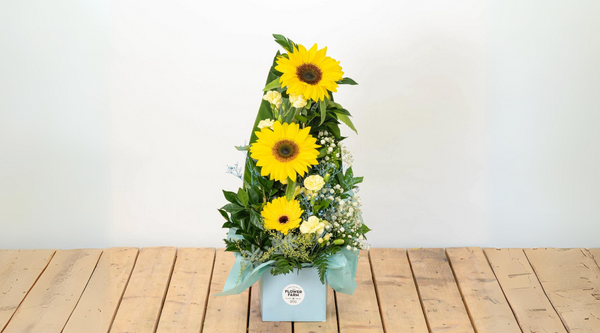Australians love fresh cut flowers! We love them all year round, and our appetite for global varieties is huge. But we don’t always have all the most commonly known blooms available here depending on the season or the type of flower.
Because of that more than 50% of all flowers sold in Australia are imported. And during the colder months, experts believe this number can rise to 90%! That’s huge.
Our love of flowers has seen the flower industry is growing every year. In fact, the global cut flower market is currently estimated to be worth $36.4 billion USD which is over $54 billion AUD. And it’s expected to rise to $45.5 billion USD (over $67 billion AUD) by 2027.
While we’re wholly supportive of a growing cut flower industry, and we love all flowers, our reliance on imported flowers can actually lead to some serious biosecurity concerns.
Potential concerns about biosecurity on imported flowers

Australia has a very robust biosecurity system which is overseen by the Department of Agriculture, Water and the Environment (DAWE) and regulated by the Biosecurity Act 2015. And since we began importing cut flowers into Australia we’ve had no foreign pests or diseases introduced via flowers.
However, with the vast increases in imported blooms that have already occurred (and are expected to continue!), the risk that we might introduce devastating pests or diseases increases. And unfortunately Australia does have a history of introduced foreign pests and diseases.
Pests and diseases can potentially be introduced in a range of ways. It could be via natural dispersal. Fall armyworm was introduced to New South Wales in this way.
It could be via the movement of people and goods. The kharpa beetle was introduced via contaminated shipping containers.
And it could be via the illegal importation of other materials which could host the pest or disease. The citrus canker was introduced to Australia via the importation of infected plant material.
The risk of pests and disease coming through the imported flower industry could potentially impact both Australia’s flower industry and the country’s agriculture and environment overall. So it’s something all Australians should be concerned about.
How to prioritise biosecurity on imported flowers
Australia does a great job with biosecurity. But there are things we can do as consumers to help.
Buy local

The best thing you can do to help combat concerns about biosecurity on imported flowers is to buy local! Buying local – choosing Australian-grown flowers over imported flowers – means that there is absolutely no risk of foreign pests or diseases being introduced.
There are lots of other benefits too when you buy locally grown flowers.
- Smaller carbon footprint
- Better quality
- Support Aussie growers
- Fewer chemicals
Expand your awareness of (and love for) Australian home grown flowers
Another great way to lower biosecurity risks on imported flowers, is to stop our reliance on those types of blooms. Because we generally have ready access to flowers grown in other countries and climates we’re used to seeing them and using them in our cut flower displays. And most of us want the flowers we want regardless of the time of year.
However, if we could change our perspective and look for flowers that are not only in season, but grown locally, we’d be in a much stronger position.
For example, most tulips are grown in Holland, but did you know that daffodils, hippeastrums and other bulbs are mainly imported from this country as well? Maybe look to use Australian natives instead of bulb flowers. (Or ensure that the bulbs you are buying are produced right here.)
Another example is Valentine’s Day. Australia only produces a fraction of the 5 million roses that are generally sold to Australians for this holiday. But if we instead considered other types of flowers, we could reduce our reliance on imported roses.
A simple change of perspective could go a long way to eliminating some of the concerns around biosecurity of imported flowers.
Be aware when you’re buying imported versus local flowers

Sometimes it’s very hard to know when you’re buying imported flowers or local flowers. Country of origin labelling rules would be fantastic. But until this is wholly adopted in Australia, we have to do our own individual investigations.
Buying from a local grower (like the Flower Farm) ensures that you’re buying locally-grown blooms. But if you’re buying from a retailer, you should always ask how their flowers are sourced. It’s best to get as close to the source as possible, in order to get the best information.
For example, a wholesaler will know precisely where their flowers are grown. And a local florist will either know, or be able to reach out to their wholesaler to find that information out. However, it will be harder to find this information from larger retailers – such as supermarkets or big box stores.
To ensure that you’re buying local, try to buy from a local grower first, a local wholesaler second and a local florist third. And be sure to ask them for details on where their blooms are grown!
Buying from the Flower Farm helps with biosecurity concerns

At the Flower Farm, we grow some of the most beautiful flowers in the world. We’re focused on sustainability and prioritising locally grown flowers, which supports local ecosystems, economies and biosecurity measures.
Buying from us is a vote for local (and a vote against biosecurity worries!). But as long as you’re making a conscious choice about where your flowers come from, you’ll be helping yourself and all of Australia.
Get in touch with our team if you have any questions about how to source locally-grown flowers or to find out more about our farm’s commitment to sustainability and flower biosecurity!


